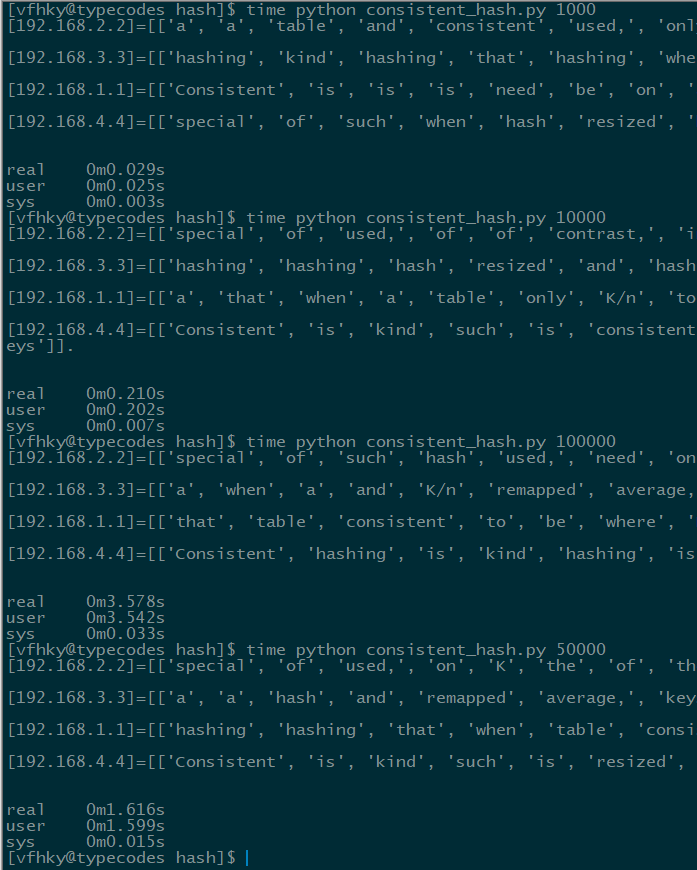分布式系统:一致性hash算法的应用
分布式系统:一致性hash算法的应用

前段时间在了解分布式,发现firefoxbug在博客中写的这篇《一致性hash在分布式系统中的应用》对这个问题说明得比较清晰易懂,本文主要是自己的理解和实践。
在后端一般会遇到这样的场景:随着应用系统的访问量或者DB/文件存储系统的数据量增大,系统由于负载增大而出现响应延迟甚至down掉的情况。为了解决这个问题,往往会对系统采用垂直扩展和水平扩展的架构设计,而分布式系统正是水平扩展架构的一种应用实践。
1 分布式系统要求
分布式设计的初衷就是为了解决单一服务端负载过大的问题,所以在对系统做水平扩展后,数据要尽量均匀地分布在每台服务器节点的上(即不会出现热点数据节点)。其次,如果后期需要扩容或者某一节点发生故障需要从集群中剔除,那么处理后的分布式系统应该做到对已存储的数据影响最小,降低数据迁移的成本和风险。
2 解决方法
由于机器的数量不可能是无限的,所以水平扩展的时候,要考虑把无限的数据通过一定的算法平衡、有序、易扩展地分布在这些机器上。
常见的做法是利用把要处理的数据进行编号,然后对机器的数据进行取模运算。例如,假设有10个数据(编号为0~9),机器数量为3(编号为0~2),那么每个数据编号对机器数3取模后,0号机器存放了编号为0,3,6,9的数据;1号机器存了编号为1,4,7的数据;2号机器存放了编号为2,5,8的数据。
取模算法比较简单,但是当某个服务器节点出现故障或者新增节点后,需要对已有数据作大量的迁移。在memcached分布式原理中介绍了Consistent Hashing算法,它能较好地解决这个问题。

3 一致性哈希算法原理
如上图所示,memcached分布式提供的哈希算法的主要处理流程如下:
1、使用算法求出每个memcached服务器节点(ip地址)的哈希值x,并将其分配到0~2^32的圆上(值域);
2、用同样的方法求出存储数据键的哈希值y,并映射到圆上。
3、按顺时针方向查找第1个比y大的x,那么y就分布在x前面那个节点上。4 示例程序
在firefoxbug的原文中提供了python2的示例程序,这里改成了python3。注意,程序中对这4台机器都使用了虚拟节点(replicas),它可以增加数据分布的均匀性。
1 2 3 4 5 6 7 8 9 10 11 12 13 14 15 16 17 18 19 20 21 22 23 24 25 26 27 28 29 30 31 32 33 34 35 36 37 38 39 40 41 42 43 44 45 46 47 48 49 50 51 52 53 54 55 56 57 58 59 60 61 62 63 64 65 66 67 68 69 70 71 72 73 74 75 76 77 78 79 80 81 82 83 84 85 86 87 88 89 90 91 92 93 94 95 96 97 98 99 100 101 102 103 104 105 106 107 108 109 110 111 112 113 114 115 116 117 118 119 120 121 122 123 124 125 126 127 128 129 130 131 132 | -*- coding: UTF-8 -*-
'''
FileName: consistenthashdistributed1.sh
Description: 分布式系统:一致性hash算法的应用
Simple Usage: python consistenthashdistributed1.py numbers of replicate
Reference: http://www.firefoxbug.com/index.php/archives/2791/
(c) 2018.02.17 vfhky https://typecodes.com/python/consistenthashdistributed1.html
'''
import sys
import hashlib
CONTENT = """Consistent hashing is a special kind of hashing such that when a hash table is resized and consistent hashing is used, only K/n keys need to be remapped on average, where K is the number of keys, and n is the number of slots. In contrast, in most traditional hash tables, a change in the number of array slots causes nearly all keys to be remapped."""
# 所有机器列表
SERVERS =
"192.168.1.1",
"192.168.2.2",
"192.168.3.3",
"192.168.4.4"
class HashRing(object):
"""Constructs.
"""
def __init__(self, nodes=None, replicas=3):
"""Manages a hash ring.
|
|---|
5 测试
上面程序在查找落地节点时,采用的是遍历整个hash圈上的值,所以虚拟节点不宜过大,否则会出现查找时间过长的问题。如下图所示,BZ在自己的单核1G内存的虚拟机中测试,发现4个节点如果都有10000个虚拟节点时在速度和均衡性方面都是不错的。
